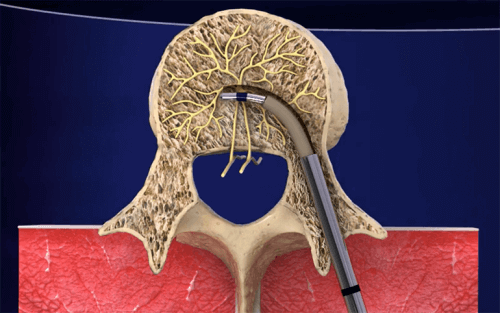Chronic Low Back Pain and the New Treatment for It


Written and verified by psychologist Valeria Sabater
Back pain, or chronic low back pain, is the most common reason for sick leave. So in this article, we’re going to talk about a new treatment that could be beneficial in reducing symptoms.
A study Annals of Rheumatic Diseases published reminds us that low back pain is, in fact, the most crippling problem today. Also, the above document states that 1 out of 10 people suffer from some type of low back pain.
This implies a high cost for medical institutions, companies, as well as patients themselves. It’s not easy to live with this condition. Besides, it tends to intensify as we get older.
Our lifestyle, which may be sedentary, overweight issues, and even our genetic inheritance undoubtedly determines its intensity too.

In today’s article, we’ll share the good news for all those who suffer from chronic low back pain. The California-based medical company Relievant Medsystems has developed a procedure to end this problem. Below you’ll find all the relevant information.
Intracept ©, the New Treatment to End Chronic Low Back Pain
Treatments for low back pain relief haven’t always been effective. For instance, physical therapy, corsets, or pain relievers are not enough to treat low back pain. Hence, patients resort to other options, such as:
- A spinal cord stimulator to relieve back pain.
- A minor spinal surgery. This is something that only takes place in few cases and is not always successful.
Also, the discs above and below affected lumbar areas sometimes tend to become overburdened. Due to the complexity of chronic low back pain treatments, Relievant Medsystems has developed a new strategy called Intracept © Procedure.
Read: Arnica and Coconut Oil Ointment to Treat Lower Back Pain
A Safe, Minimally Invasive Procedure

- First, the patient lies face down to receive local anesthesia in the area between the L3 and S1 vertebrae.
- Next, the surgeon introduces a very fine needle-like device into this area. Its purpose is to cancel the activity of the basivertebral nerve.
- This nerve sends pain signals from the spine to the brain, as this study from The Spine Journal indicates. With this quick procedure and local surgery, they can end a patient’s suffering.
- This treatment uses radiofrequency, rather than a scalpel and does not create any wound that is difficult to recover from.
The radiofrequency is transmitted through the device and the patient feels only a little heat when the surgeon disables the nerve. After this, the surgeon removes the device efficiently and without creating any complications. In fact, the whole process lasts just over an hour and then the person can go home.
The Pain Doesn’t Reappear
This new technique has already been approved by the US Food and Drug Administration (FDA), as this Public Health Service document shows. In a few months, will also be used in Europe, when the appropriate medical institutions give their consent.
- All individuals who have undergone a basivertebral nerve ablation enjoy a better quality of life. In fact, their pain has not reappeared.
- It should be pointed out that patients who can have this procedure are those who suffer from chronic low back pain.
- This treatment is therefore not suitable for occasional back pain.
- Nerve ablation isn’t something new. It has already been used for other types of ailments where ordinary medicine has not been effective.

Intracept © for chronic low back pain has been very useful
Surgeons have performed nerve ablation in various different ways. For example, they can use cryoablation to kill those nerves, but now radiofrequency has opened a very interesting opportunity to treat chronic low back pain.
All cited sources were thoroughly reviewed by our team to ensure their quality, reliability, currency, and validity. The bibliography of this article was considered reliable and of academic or scientific accuracy.
- Hoy, D., March, L., Brooks, P., Blyth, F., Woolf, A., Bain, C., … & Murray, C. (2014). The global burden of low back pain: estimates from the Global Burden of Disease 2010 study. Annals of the rheumatic diseases, 73(6), 968-974. https://ard.bmj.com/content/73/6/968
- Relievant Medsystems. (n.d.). The Intracept Procedure targets the basivertebral nerve for the relief of chronic vertebrogenic low back pain. https://www.relievant.com/intracept-procedure/
- Public Health Service. (2016). Intracept Intraosseous Nerve Ablation System
https://www.accessdata.fda.gov/cdrh_docs/pdf15/K153272.pdf - Fras, C., Kravetz, P., Mody, D. R., & Heggeness, M. H. (2003). Substance P–containing nerves within the human vertebral body: an immunohistochemical study of the basivertebral nerve. The Spine Journal, 3(1), 63-67. https://www.sciencedirect.com/science/article/abs/pii/S1529943002004552
This text is provided for informational purposes only and does not replace consultation with a professional. If in doubt, consult your specialist.








